If we don't take into account the trio of minivans (Fiat Qubo, Peugeot Bipper and Citroën Nemo) only the Suzuki Baleno, Honda Jazz and Skoda Fabia have a larger boot without reaching four metres in length. The C3 maintains the volume of 300 liters of its predecessor, five comfortable seats and a slightly better dimensions in length and width. In terms of height does not improve because the roof is lower, and begins to stay just above 1.80 meters tall.
This model is characterized by its comfort, the casual image and the technological aspect. Considerations such as handling on winding roads, responsive engines and driving fun take a back seat. It is not exactly a piston model, but it has some very clear advantages for those who appreciate them. It is clearly focused on a young and urbanite public, lover of new technologies and social networks.
C4 Cactus-style design
The French utility takes several features previously seen in C4 Cactus, as the 16-inch wheels (equal), the lower protections of black plastic, the lights at half height on a high hood (like the Nissan Juke), notes of color and the famous Airbumps that protect the sides. Almost all the press photos that we are going to see of the Citroën C3 correspond to high range, the Shine, which have the Airbumps and the roof of a different color to the body. In the photos the pastel green unit is Feel (intermediate), the white one is Shine (top of the range).
The basic Live and Business are not so decorated and are more conventional utilitarian.
There are 36 exterior color combinations, mixing the nine paint colors with the roof (same color, black, red or white). In addition, the edges of the fog lights, the mirror housings and a circle inside the Airbumps stand out in contrasting color. At the presentation in Barcelona were exposed roofs with vinyls that gave it even more personality, although not detailed in the press kit at all. The A-pillars are always painted black. The use of black plastic underneath gives the impression that the wheels are much bigger than they really are.
Inside we also notice influences from the C4 Cactus, such as the design motifs inspired by the world of travel and luggage (like the door handles), very comfortable seats, the floating touchscreen in the center of the dashboard, etc.. On the other hand, solutions like the windscreen washers embedded in the wiper blades have not been carried over to this model, this one has conventional rear windows and the dashboard is analogue/digital. Yes, this one has a rev counter, you don't have to drive by ear.
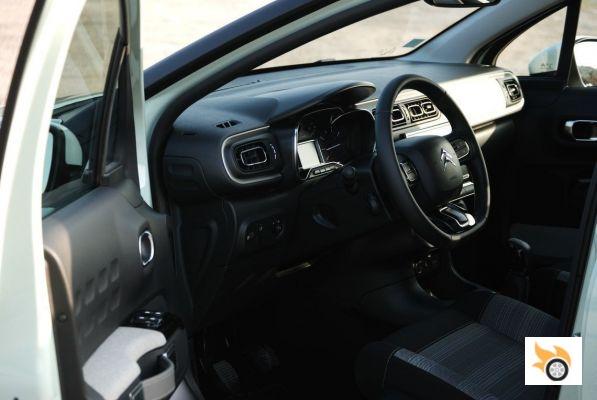
It has four interior environments, with textile or plastic inserts, which move away from the typical dashboard that is black or black. It has cheerful and casual shapes, the usual in the brand, which has left the previous model very bland. The design of the steering wheel changes depending on the chosen environment in some cases, and a colleague commented that he didn't like the feel of it. The quality of the finishes is correct, but not outstanding. One of its strong points is the ergonomics, it's very easy to find the ideal position at the wheel.
Don't let the design fool you, it's a pure and simple car, it only looks like a crossover. The product managers have made no mention of the intelligent traction control that the C4 Cactus Rip Curl has. It's not that it's a technical headache to install it, it's just a simple programming of the traction control and more versatile tyres when going off-road. The C3 uses road and fuel efficient Goodyear Efficientgrip tyres.
The seats are roomy, soft and very pleasant. They reinforce the feeling of isolation to which the C3's passengers are subjected. It's all very zen-like. The engines are not particularly noisy, they have a massage function - due to the rattling of its three petrol cylinders - and the noise from outside is very well concealed. The atmosphere on board the C3 is carefree, it doesn't encourage you to rush, but to take it easy. After two hours of driving a warning will pop up recommending you to stop and have a coffee, it almost seems designed by Starbucks, because every hour it will repeat the warning if you ignore it.
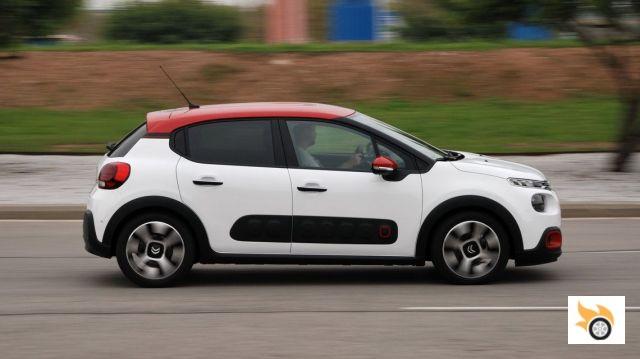
Not a lot of noise, not a lot of nuts
The C3 is a haven of peace until it's time to overtake. In the case of the naturally aspirated C3 Puretech 82, if the low gears are squeezed to gain agility, we will notice the injection cut at about 95 km / h in second and 125 km / h in third. I've seen smoother injection cut-offs at any gathering of freaky poligoneros (healthy cut-offs); it's abrupt and unpleasant, and I'd even bet it will scare off unusual, god-fearing or novice drivers. You don't want to rush it up to 6,500 RPM if you want to avoid the phenomenon.
The 82 hp engine seemed to me to be just enough to drive off motorways and highways with a minimum of agility, overtaking must be calculated very well, because it accelerates little and lazily. There is a less powerful engine, the Puretech 68, which I only recommend it to those who leave the city little and do it in a mainly flat province ... and circulate little accompanied. I leave two data to reflect, the 68 hp reaches 100 km / h in 16.3 seconds, the 82 hp needs 14.9 seconds. Not all engines have Stop&Start, but those that do are satisfactory because of the quick start.
The seats are a joy to sit on, but they barely hug the body when cornering, and that's without going fast!
The C3's suspension is very soft and favours comfort, but that has its counterpart: it sways more and has not very agile reactions. The steering wheel conveys very little about what's happening under the wheels. Citroën intentionally wanted to make a car disconnected from the road, but connected to modernity in other ways. In contrast to this image of zero sportiness, this is the car on which the next WRC car, the C3 WRC, is based. What irony in only 3.99 meters long.

Another striking aspect of the car is the enormous slack in the manual gearbox, where an inserted gear allows the knob to move as much as the neutral position of a sports car. I didn't find it satisfactory. As for the automatic gearbox in the Puretech 110, which will be sold later, I found it unintuitive too. Yes, there is a graphic explaining how the selector goes, and you have to look way down to see it. At least it has "S" mode (I won't say sporty, I won't say sporty, no...) and "W" for easier starting in low grip.
The 110 hp engine, which does have a turbo, is more lively in its power delivery and almost doubles the maximum torque of the naturally aspirated one, but I didn't like the gearbox programming either. It's a torque converter (EAT6) and in theory very smooth, but it occasionally inserts the gears with the same delicacy as a robotic manual of the bunch. Compared to the previous generation of PSA automatics, the CMPs, yes, it's a step up, but any dual-clutch transmission will do better.
In terms of engines and performance, the C3, for me, neither fu nor fa. It is not a model that incites me to enjoy driving in a sense, but if what I was looking for is a small car, very comfortable, and that does not involve a huge outlay of money, I can think of few alternatives. Citroën wanted a comfortable car and they got it. If it were not because as a tester I have some obligation to tell what happens in very varied conditions, I would have circulated very quietly and calmly, because it is what the car invites you to do.
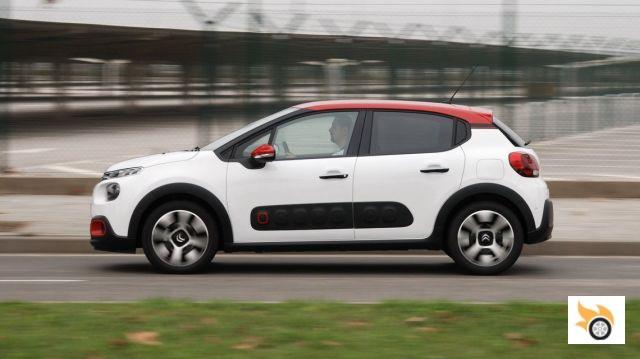
Regarding the performance of both engines, normal to average. The homologated figures I do not bother to look at them, because the brand, in a gesture of honesty that honors him, has also given the consumption obtained by Transport & Environment in more realistic conditions of use. The 82 bhp Puretech got 6 l/100 km, the 110 bhp automatic 6.8 l/100 km. These figures are virtually identical to the trip computer readings of the cars tested. Non-PSA manufacturers, take note, thank you.
Only engines with 100bhp or more use rear disc brakes, the rest use drums.
Having commented on the mechanical aspects, it's time to move on to the technological ones. The central touchscreen is very cool and eliminates a lot of buttons, but I find it a bit distracting. Firstly, it's positioned a bit downwards, and secondly, when buttons are removed, you have to learn menus to do something quickly and without taking your eyes off the road. The Peugeot 208 has the screen placed in a much more optimal position.
Like the vast majority of recent launches, allows you to connect the latest generation mobile phone so that the most common applications are handled safely, such as the browser, find a contact in the phonebook to call or tune a radio station. Some commands can be executed by voice. Technology always has a double aspect, it can be used for good or for evil. I'll pull Rousseau for this one. By the way, I loved the speed limiter, when the legal limit changes it gives a warning (it reads it with the camera), and with a touch of a button we can change the voluntary limit to avoid an unexpected flash.
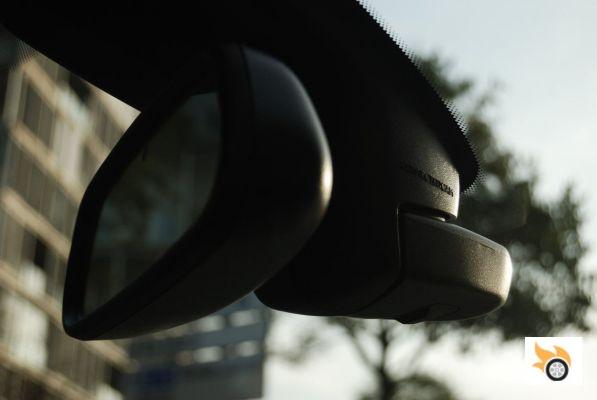
A car hooked to modernity
One of the novelties of this car is the Connected Cam, a camera housed in front of the rearview mirror, always standard on Shine and optional on Feel, which records what the occupants see with a wide angle (120 º) in a 2 megapixel HD camera, at 1920×1080. It stores up to 16 GB of data, and that includes photos and video. The driver or passenger can, at will, take a picture of something happening in front of the car, or record a short video. This content can be saved to the mobile phone via WiFi or safely uploaded to social networks, provided the phone is compatible, of course.
To operate the camera, just stretch out your arm and press the lower button.
In the event of a strong deceleration, not necessarily a total loss, the time lapse between 30 seconds before the incident and 60 seconds after is automatically recorded. In this way it is possible to determine who is responsible if someone makes a mistake. According to the creators of the car, the idea is to be able to share moments behind the wheel, such as sunsets or when someone crosses a pedestrian crossing. They didn't say the latter, but I can vouch for the system's usefulness.
And why not put a camera on the dashboard to take selfies? Before you think about stoning me with rusty pistons, think about it. If we can't avoid the trend of people taking pictures of themselves driving (or having an impromptu karaoke), let them do it safely. A little button on the steering wheel, and you can get the perfect selfie without taking your hands off the wheel. They gave me a non-explanation to that question, i.e. they talked about the car's front-facing camera. It's the same camera that some active safety systems depend on, she's a jack-of-all-trades. In the competition that camera never records images.
I also asked if they were not afraid that the C3 cannibalize sales to the C4 Cactus, which is being manufactured in Spain and a plant depends entirely on it, the Villaverde (Madrid). Carlos Adán, product manager of the C3 for our country, believes that they are aimed at different customers. That doesn't make sense to me, with the same version, the C4 Cactus costs practically the same as the C3, 200 euros difference in some cases. They are as similar as two drops of Jägermeister in the dark, so I think there will be cannibalization; I hope it benefits the guys from Villaverde.
In our country the C3 is going to be marketed in all its variants. Sales start today, with a starting price of 11,750 euros for the 68 hp engine, Live finish, and without air conditioning or radio with USB. To get those two things you'd have to fork out another 1,100 euros, so the realistic launch price is 12,850 euros. The most expensive model is less than 20,000 euros. There will be no versions above 110 hp, no three-door, no cabriolet, no diesel automatic, and no word on alternative engines (if anything, an LPG one).
There are three petrol engines, all 1.2 three-cylinder, with 68, 82 and 110 hp, all with manual gearboxes. There are two petrol engines, the 75bhp and 100bhp, both four-cylinder. There will be those who prefer the diesels in terms of subjective characteristics, or for any other reason, so don't just think in terms of fuel consumption. Personally I think the BlueHDi can be more enjoyable than the three-cylinder, and in the lower power range, having a turbo is cooler; the 75bhp BlueHDi moves the car more happily than the 68bhp Puretech.
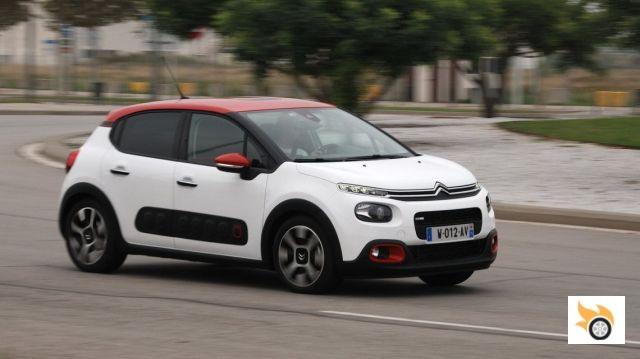
Equipment at a glance
The most basic finish, Live, highlights the basic safety systems (ABS, ESP, pressure sensors, six airbags ...), regulator and speed limiter, electric front windows, on-board computer, seat adjustment and full driver's steering wheel, front camera functions (lane departure warning, traffic sign recognition) ... Not worth it, for what it costs the air conditioning package we take the Feel.
The Feel enriches the above with fog lights, air conditioning, electric and heated mirrors, LED daytime running lights (otherwise halogen) and the stereo. The wheels are also 15″ and sheet metal, but the tires go from 185 to 195 wide. By the way, the basic ones don't have the black protectors on the wheel arches, from the Feel onwards they do. You can see it in the image below.
The Business adds to the Feel the automatic climate control, touch screen and advanced connectivity features. Finally, the Shine adds, in addition to what is mentioned in the Business, two-tone roof, 16″ aluminum wheels, light and rain sensors, rearview camera, leather steering wheel, tinted windows, anti-glare rearview mirror, rear power windows and rear parking sensors. I'm practically convinced that the ones we'll see most on the road will be the Shine, the most cute and equipped, as has happened to the Renault Captur.
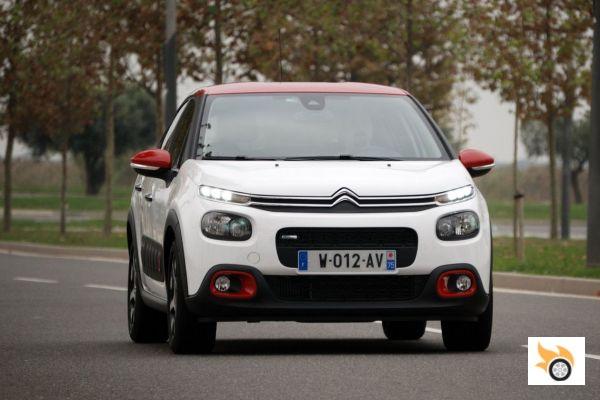
Price list
| Version | Engine | Price |
|---|---|---|
| C3 Live | Puretech 68 | 11,750 euros |
| C3 Feel | Puretech 68 | 12,850 euros |
| C3 Feel | Puretech 82 | 13,500 euros |
| C3 Shine | Puretech 82 | 15,950 euros |
| C3 Feel | Puretech 110 | 14,900 euros |
| C3 Shine | Puretech 110 | 17,350 euros |
| C3 Live | BlueHDi 75 | 14,000 euros |
| C3 Feel | BlueHDi 75 | 15,100 euros |
| C3 Shine | BlueHDi 75 | 17,550 euros |
| C3 Feel | BlueHDi 100 | 16,000 euros |
| C3 Shine | BlueHDi 100 | 18,450 euros |
| C3 Business | Puretech 82 | 15,150 euros |
| C3 Business | BlueHDi 75 | 16,750 euros |
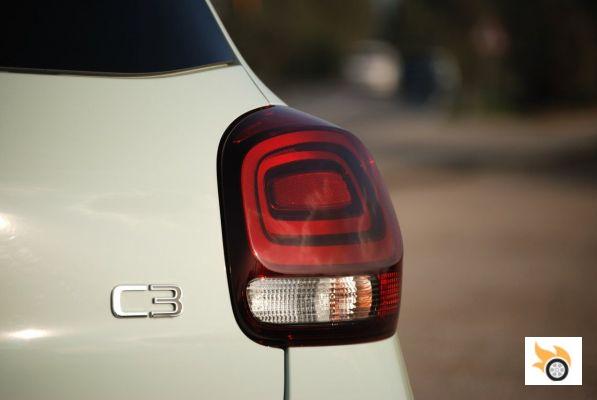
All versions of the Citroën C3 are exempt from registration tax due to low homologated CO2 emissions. As they are all Euro 6, they will carry the green emissions sticker, the C.

























